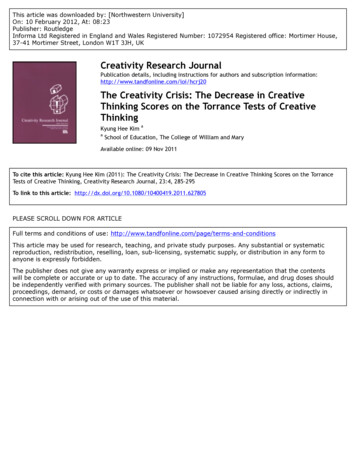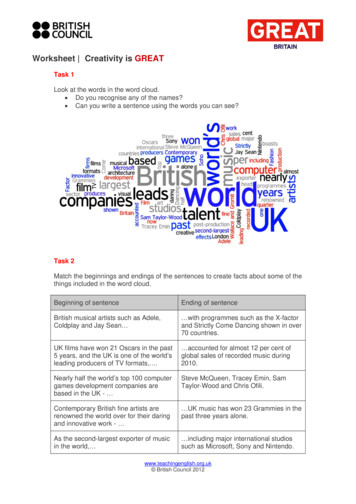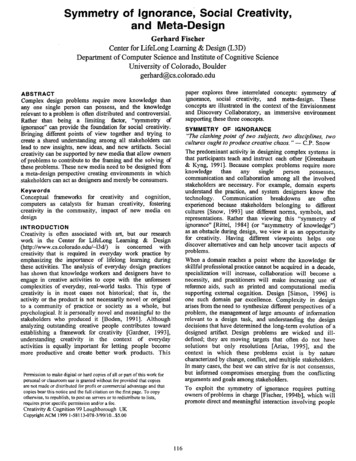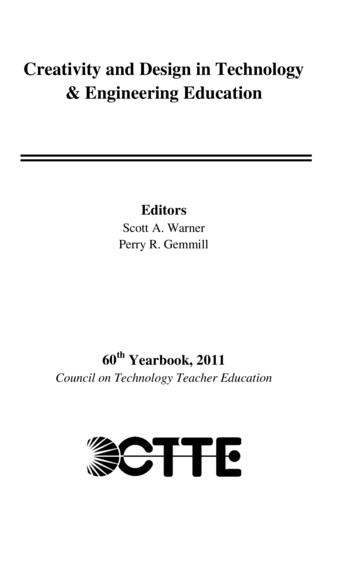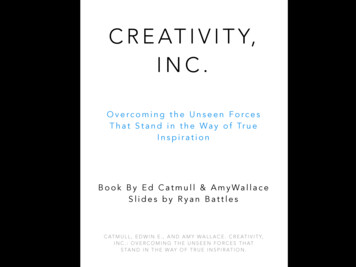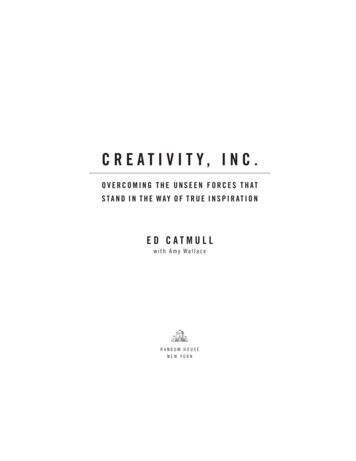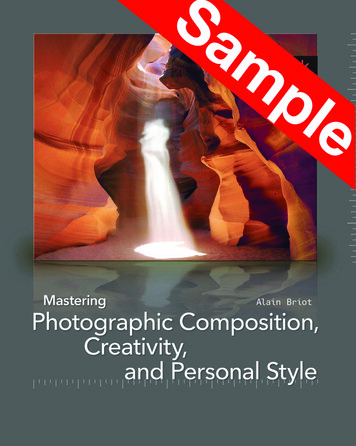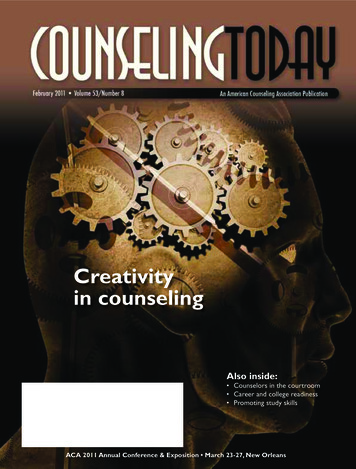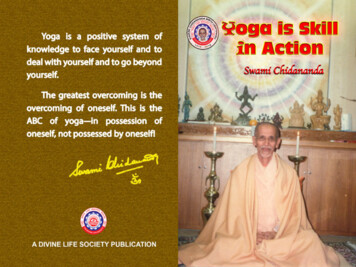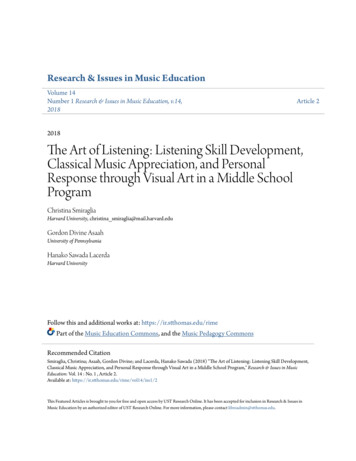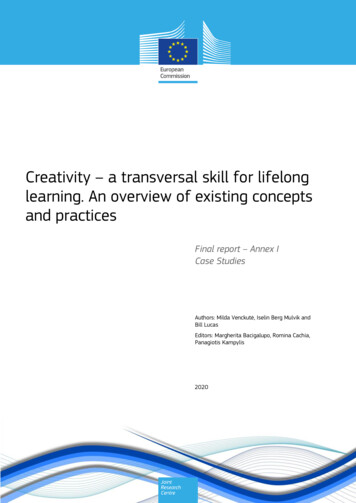
Transcription
Creativity – a transversal skill for lifelonglearning. An overview of existing conceptsand practicesFinal report – Annex ICase StudiesAuthors: Milda Venckutė, Iselin Berg Mulvik andBill LucasEditors: Margherita Bacigalupo, Romina Cachia,Panagiotis Kampylis2020
This publication is a report by the Joint Research Centre (JRC), the European Commission's science and knowledge service. It aims toprovide evidence-based scientific support to the European policymaking process. The scientific output expressed does not imply a policyposition of the European Commission. Neither the European Commission nor any person acting on behalf of the Commission isresponsible for the use that might be made of this publication. For information on the methodology and quality underlying the data usedin this publication for which the source is neither Eurostat nor other Commission services, users should contact the referenced source. Thedesignations employed and the presentation of material on the maps do not imply the expression of any opinion whatsoever on the partof the European Union concerning the legal status of any country, territory, city or area or of its authorities, or concerning the delimitationof its frontiers or boundaries.This report was prepared as part of the study' Creativity – a transversal skill. An overview of existing concepts and practices', which wascommissioned by the European Commission's Joint Research Centre and conducted by PPMI and prof. Bill Lucas.Contact informationName: Margherita BacigalupoEmail: margherita.bacigalupo@ec.europa.euEU Science Hubhttps://ec.europa.eu/jrcJRC122016PDFISBN 978-92-76-27447-6doi:10.2760/33215Luxembourg: Publications Office of the European Union, 2020 European Union, 2020The reuse policy of the European Commission is implemented by the Commission Decision 2011/833/EU of 12 December 2011 on thereuse of Commission documents (OJ L 330, 14.12.2011, p. 39). Except otherwise noted, the reuse of this document is authorised underthe Creative Commons Attribution 4.0 International (CC BY 4.0) licence (https://creativecommons.org/licenses/by/4.0/). This means thatreuse is allowed provided appropriate credit is given and any changes are indicated. For any use or reproduction of photos or othermaterial that is not owned by the EU, permission must be sought directly from the copyright holders.All content European Union, 2020How to cite this report: Venckutė, M., Berg Mulvik, I., Lucas, B., Creativity – a transversal skill for lifelong learning. An overview of existingconcepts and practices. Final report, Annex I (Bacigalupo, M., Cachia, R., Kampylis, P., Eds.), EUR 30479 EN, Publications Office of theEuropean Union, Luxembourg, 2020, ISBN 978-92-76-27447-6, doi:10.2760/33215, JRC122016.
ContentsList of abbreviations .4Introduction.5Tinkering EU.6Victorian Curriculum and Assessment.19IDEO Creative Difference .33Lead Creative Schools .41Design IT.49TECRINO .63Creative Thinking in Youth Work.73High-performance cycles (ETHAZI) .833
List of abbreviationsCPSICreative problem-solving instituteCCTCritical and creative thinkingDeSeCoDefinition and selection of competenciesDigCompThe European Digital Competence Framework for CitizensECECEarly childhood education and careEntreCompThe European Entrepreneurship Competence FrameworkERI-NetAsia-Pacific Education Research Institutes NetworksEUEuropean unionICTInformation and communication technologyJRCJoint Research CentreHEHigher educationLifeCompThe European Framework for the Personal, Social, and Learning to Learn Key CompetenceMENAMiddle East and North-AfricaMOOCMassive open online courseNGONon-governmental organisationOECDOrganisation for Economic Co-operation and DevelopmentO*NETOccupational Information NetworkP21Partnership for the 21st Century LearningPISAProgramme for International Student AssessmentSTEMScience, technology, engineering and mathematicsTTCTTorrance tests of creative thinkingUNICEFUnited Nations Children's FundUNESCOUnited Nations Educational, Scientific and Cultural OrganizationVETVocational education and trainingWEFWorld Economic Forum4
IntroductionThe purpose of the case studies was to reveal how creativity is conceptualised, translated into learning objectives, taught, andassessed.Out of 34 cases described for the inventory (see Annex II to the present report), eight were selected for a more detailedreview:-Three 'Tinkering EU' projects: 'Tinkering: Contemporary Education for Innovators of Tomorrow', 'TinkeringEU: Building Science Capital for ALL', and 'Tinkering EU: Addressing the Adults';-'Design thinking in higher education for promoting human-centred innovation in business and society';-'Teaching creativity in engineering';-Victorian curriculum and assessment;-IDEO Creative Difference;-Lead Creative Schools;-'Creative thinking in youth work';-High-performing cycles (ETHAZI).These are well-documented policy and grass-root initiatives of broad scope, high degree of maturity, and observable impact.Together, they cover different countries, sectors, levels and settings of education and training, focus areas, target groups,levels of implementation, and funding arrangements.For each case, desk research was conducted along with email enquiries and telephone interviews with the people involved intheir design and/or implementation. Concise yet informative case study reports were then prepared, covering such aspects asdesign features, conceptualisation of creativity, teaching and learning, assessment, results, key drivers and challenges, andlessons learned. To boost the accuracy and facilitate the interpretation of the descriptions, throughout them, terms adopted bythe case owners are used5
Tinkering EUAt a glanceAdults as educators and learners; in the first two projects, school-age children as wellTarget group(s)Sector(s), level(s), and Non-formal learning, museum, and other non-formal settingssettings coveredLevel of implementationEuropeanFunding arrangementsFunded by the European Commission (Erasmus Programme 2014-2020)Key premisesMaking and tinkering practices serve to develop important lifelong learning skills suchas creativity, divergent thinking, innovation, problem-solving, persistence, determination,self-motivation, and entrepreneurshipDefinition of creativityCreativity was not clearly defined but linked to thinking creatively, working creativelywith others, and implementing innovationsRelatedcompetences Innovation, entrepreneurship, self-confidence, and critical thinkingand skillsPedagogical approaches Tinkeringand methodsAssessment approaches No formal assessment, in the second project – an observation of learners and reflectionupon their experienceand methodsDriversBarriersResultsKeymessageslessons learned-The novelty and potential of tinkering, which allowed to build a strongcase for learning-The strength of the Consortium and complementary experiences of itsmembers-Training workshops for museum educators and teachers beforeinvolving them in the tinkering activities with the children through themultiplier events-Having teacher ambassadors in the second project-Beginning at the museums, and then moving on to engaging thedisadvantaged communities and adults-Challenges to sustain the engagement of teachers throughout theproject duration (three years)-Lack of direct interaction among the partners throughout the projectduration (three years)Promotion of tinkering and improvement of learner skills (including creativity).and -Tinkering offers much potential for the development of creativity as atransversal skill and is particularly well suited for informal learning.-Tinkering also has much potential towards underserved/vulnerablegroups.Tinkering activities may look simple, but they are underpinned by complex pedagogies6
and based on thorough research; to conduct them successfully, one needs to study themethodology (ideally, participate in training), try to deliver activities that have alreadybeen tested, observe the participation of learners and reflect upon it.IntroductionIn the sections below, we provide a detailed description of three Erasmus projects implemented one after the other under thesame name ‘Tinkering EU’. These are:-‘Tinkering: Contemporary Education for Innovators of Tomorrow’ (project reference: 2014-1-IT-02KA200-003510), henceforth ‘Tinkering EU 1’-‘Tinkering EU: Building Science Capital for ALL’ (project reference: 2017-1-IT02-KA201-036513),henceforth ‘Tinkering EU 2’-‘Tinkering EU: Addressing the Adults’ (project reference: 2019-1-NL01-KA204-060251), henceforth‘Tinkering EU 3’First, we outline the design of each project, specifying the context, objectives, timeframe, level of implementation,geographical scope, target groups, sectors, levels, and settings covered, key activities, actors involved and fundingarrangements. Second, we explore how creativity has been defined and embedded in project activities. Third, we explain theTinkering methodology and how it has been applied to develop the 21st century skills. Fourth, to the extent that existing dataallows, we present the results of and lessons learned from the first two projects.The description of ‘Tinkering EU’ is primarily based on desk research. All projects have been very well documented. Key sourcesreviewed include project websites,1 the Final Report of the ‘Tinkering EU 1’, the Interim Report of the ‘Tinkering EU 2’,descriptions of projects retrieved from the Erasmus Project Results Platform and project resources. To complement deskresearch, in-depth interviews were conducted with the coordinator of ‘Tinkering EU 1’ and ‘Tinkering EU 2’ – dr. MariaXanthoudaki (Director of Education and Centre of Research in Informal Education (CREI) at the National Museum ofScience and Technology ‘Leonardo da Vinci’, Milan, Italy) and coordinator of ‘Tinkering EU 3’ – Inka de Pijper (SeniorProject Manager in Education at the NEMO Science Museum, Amsterdam, the Netherlands). To boost the validity of theanalysis and reliability of the research results, we have applied the principle of triangulation – where possible, verifiedinformation by cross-checking different data sources.Design of the initiativeContext and objectivesThe three ‘Tinkering EU’ projects were launched to help individuals develop their STEM competences and 21st century skillssuch as creativity, innovation, entrepreneurship, self-confidence, and critical thinking. Each initiative intended to do so throughthe international cooperation for the educational innovation – the promotion of Tinkering mainly in the informal (museum) butalso formal (school) settings. Developed by the Exploratorium in San Francisco, California, Tinkering had proven to be apowerful tool contributing to the improvement of the key competences and transversal skills, and connecting scienceknowledge and skills with the requirements of the contemporary labour markets (National Museum of Science and Technology‘Leonardo da Vinci’, 2020a).Tinkering has emerged over the last decade from the successful ‘maker movement’ – a social, technological, and economicgrassroots movement which celebrates do-it-yourself (DIY) and do-it-with-others (DIWO) making practice through artisancrafts and emergent technologies using physical and digital resources (Brahms, 2014). Within the maker community, ‘making’is typically characterised by people coming together to use, share, manipulate and innovate tools, materials, ideas, andmethods (Harris, Winterbottom, Xanthoudaki, Calcagnini, and de Pijper, 2016). The outcomes of the making process can bevery diverse. These features of making attract tens of thousands of people each year, all despite the concerns of the scientificeducation community about the increasing disaffection with the role of science and technology (Ibid). According to Harris et al.,practices emerging within maker communities embody many of the core features of the inquiry-based science educationapproaches often applied in STEM (2016). Moreover, evidence shows that making practices serve to develop important lifelonglearning skills such as creativity, divergent thinking, innovation, problem solving, persistence, determination, self-motivation,and entrepreneurship. For these reasons, informal science learning institutions, mainly in the USA, set out to get people toexplore scientific phenomena directly through playful, immersive, creative, and physical activities that are learner-centred anddriven by individual motivations and personal interests (Ibid). The Exploratorium has been developing, testing, and refining1The website of Tinkering EU 1 is available at http://www.museoscienza.it/tinkering-eu/, the website ofTinkering EU 2 – at http://www.museoscienza.it/tinkering-eu2/, and that of Tinkering EU 3 – athttp://www.museoscienza.it/tinkering-eu3/.7
making activities since 2008 and continues to invite visitors to investigate, experience, and explore scientific phenomenathrough carefully designed making activities using a range of tools, materials and technologies. This is called Tinkering, workon which was consolidated into methodology – STEM-rich branch of making which emphasises creative problem solving,thinking with hands learning through iterative design and testing (Ibid).Key learning dimensions of tinkering include initiative and intentionality, problem-solving and critical thinking, conceptualunderstanding, creativity and self-expression, social and emotional engagement. Thus, creativity is required in any tinkeringactivity (Exploratorium, 2017).Inspired by the potential of this methodology, maker movement placing value on an individual’s capability to create, and ashift in the discourse on education towards student-centred learning, ‘Tinkering EU 1’ was launched. The key goal was tointroduce Tinkering in Europe – build the know-how within the Consortium and then disseminate it to create a community ofpractitioners working with this methodology (National Museum of Science and Technology ‘Leonardo da Vinci’, 2020b). Thefirst project suggested that Tinkering may have potential in school education, hence the aim of ‘Tinkering EU 2’ to explore theuse of Tinkering for the development of science capital in schools of the disadvantaged communities (National Museum ofScience and Technology ‘Leonardo da Vinci’, 2020a). Having learned about the potential of Tinkering to help engage vulnerablegroups, ‘Tinkering EU 3’ was launched to foster the socio-educational and personal development of disadvantaged adults(National Museum of Science and Technology ‘Leonardo da Vinci’, 2020c).The context, general and specific objectives of each project are outlined in the table below. While all the three projects centreon the promotion of Tinkering, certain aspects of them differ, e.g. the empowerment and social inclusion through andthirdprojectsonly.8
Table 1. Context, General and specific objectives of the ‘Tinkering EU’ projectsSource: Compiled by the authors based on the data retrieved from the Erasmus Project Results Platform and project websites.9
TimeframeThe three projects have been implemented one after the other since 2014. Each has or will have had taken three years. Thetimeline of the three projects is outlined in the figure below.Source: Compiled by the authors based on the data retrieved from the Erasmus Project Results Platform.Figure 1. Timeline of the ‘Tinkering EU’ projectsLevel of implementation and geographical scope‘Tinkering EU’ projects have been implemented at the European level. The number of countries participating in ‘Tinkering EU 1’was five. It increased to seven in ‘Tinkering EU 2’ and dropped by one in ‘Tinkering EU 3’. While Italy, the Netherlands and theUnited Kingdom have engaged in all three projects, Austria has participated in the last two, and the rest of the countries havebeen involved in either the first (Germany and Hungary), or second (Ireland, Spain and Greece), or third (France and Poland)project. The map below identifies countries that have participated in ‘Tinkering EU’ and specifies how many projects they havejoined.Map 1. The geographical scope of the ‘Tinkering EU’ projectsSource: Compiled by the authors based on the data retrieved from the Erasmus Project Results Platform.Note: The darker the colour, the more ‘Tinkering EU’ projects an organisation(s) from a given country joined.Target groups, sectors, levels and settings of education and training coveredThe primary target group of ‘Tinkering EU 1’ was adults, particularly parents, museum educators and teachers of secondaryschools. Parents participated in the tinkering activities with their children, whereas teachers – with students from 12 to 18years old (National Museum of Science and Technology ‘Leonardo da Vinci’, 2020b).‘Tinkering EU 2’ set out to address museum educators as well as primary and junior high school teachers. The latter havejoined tinkering activities with their students from 8 to 14 years old (European Commission, n.d.). The focus has been onschool groups from communities characterised by a socio-economic, educational, cultural, and/or linguistic disadvantage.10
The third and on-going ‘Tinkering EU’ project aims to address adults from underserved groups, e.g. refugees, asylum-seekers,people with low income, mental health issues, ex-offenders, unemployed adults and young adults not in formal education(National Museum of Science and Technology ‘Leonardo da Vinci’, 2020c). The intention is to reach these adults through theinvolvement of their educators.All the three projects have been heavily focused on the professional development of educators – museum and schooleducators in the first two, museum and other adult educators in ‘Tinkering EU3’. Learners have also been directly involved,primarily through the multiplier events. The last two projects have been set out to reach vulnerable groups (school students inthe second project and adults in the third one).All project activities have been implemented in science museums where informal learning takes place. Partners of the first twoprojects intended for Tinkering to also be transferred by teachers from there to schools.Key activities‘Tinkering EU’ projects have been designed in a similar way and comprised certain types of activities each:2-Development of the (theoretical and) methodological frameworks. While the first one focused onthe key features, benefits, and applications of Tinkering, the second one linked it to the development ofscience capital and inclusive STEM teaching at school. As part of the third project, a framework linkingTinkering with equity and inclusion in STEM and education of underserved adult groups is now beingprepared.-Tinkering activities. In the first project, new activities were designed and tested with school and familyaudiences. In the second one, activities well-suited for schools were selected and tested with teachersand students from disadvantaged communities. The third project intends to tailor certain activities for thedisadvantaged adults and test them with adult educators and learners.-Development of pedagogical materials. As part of the first project, the following were produced: apractitioner guide, a guide to tinkering activities and professional development guidelines. In the secondproject, tinkering activities for schools from the disadvantaged communities have been compiled, andobservation and reflection tools are now being prepared. Within the frames of the third project, guidelinesfor focus groups will be developed to help museum educators work with adult groups and families,especially those from the disadvantaged communities.-Training workshops. All workshops have focused on sharing the knowledge and practice of Tinkering. Inthe first two projects, educators from museums and schools joined, whereas the third project foreseestraining for those working with disadvantaged adults (be it museum staff or educators from thecommunity organisations).-Multiplier events. In all the three projects, multiplier events (will) have been used to showcase tinkeringactivities and promote Tinkering at a larger scale. While the first project focused on engaging familiesand school groups, the second one – teachers and students from disadvantaged communities, the thirdproject is set out to reach adult educators and learners from vulnerable groups.-Project management, monitoring and dissemination. So far, the latter has been done mainlythrough presentations at conferences and other events, publications, and project websites.The activities of each project are specified in the table below.2The following overview is a synthesis of information retrieved from the project websites, Erasmus ProjectResults Platform, and verified with the project coordinators.11
Table 2. Activities of the ‘Tinkering EU’ projectsSource: Compiled by the authors based on the data retrieved from the Erasmus Project Results Platform and project websites.Key actors involvedThe consortia of the first two projects comprised seven organisations, whereas that of ‘Tinkering EU 3’ – one less. TheNational Museum of Science and Technology ‘Leonardo da Vinci’ (Italy), NEMO Science Museum (the Netherlands) andCambridge University (the United Kingdom) have joined all three projects; ScienceCenterNetzwerk has participated inthe last two; whereas the rest of the partners in either ‘Tinkering EU 1’, ‘Tinkering EU 2’ or ‘Tinkering EU 3’ (see the tablebelow).The National Museum of Science and Technology ‘Leonardo da Vinci’ has served as a coordinator of ‘Tinkering EU 1’ and‘Tinkering EU 2’, whereas NEMO Science Museum has been coordinating the third one. Partners involved have contributed tothe implementation of all project activities, except for Cambridge University, which has been focusing on the development ofthe theoretical and methodological frameworks as well as pedagogic materials and educational tools.Table 3. Organisations involved in the implementation of the ‘Tinkering EU’ projectsLegal nameShort name inEnglishType oforganisationCountryRole in rTinkering EU 1and 2ProjectpartnerTinkering EU 3ProjectpartnerTinkering EU 1and 2ProjectcoordinatorTinkering EU 3ProjectpartnerTinkering EU 1,2 and 3Participated in all three projectsFondazione rdo da Vinci’National Museumof Science andTechnology‘Leonardo da Vinci’Stichting Nationaal NEMOCentrumvoor MuseumWetenschapenTechnologie, NEMOScience MuseumUniversityof CambridgeCambridge, Faculty Universityof EducationScienceScienceandtechnologymuseumScience museumUniversityItalyTheNetherlandsThe UnitedKingdomParticipated in two out of three projects12
Tinkering EU 2and 3Participated in one out of three projectsInternational Centre Lifefor Life TrustScience centreThe UnitedKingdomProjectpartnerTinkering EU 1Deutsches Museum Deutsches Museumvon MeisterwerkenderNaturwissenschaftund tnerTinkering EU 1HungaryProjectpartnerTinkering EU mÁnyos VocationalÁnyos JedlikVocationalSchoolschoolésésMOBILIS Közhasznú MOBILISNonprofit KorlátoltFelelősségűTársaságScience centreHungaryProjectpartnerTinkering EU 1College of the Holy Science Gallery ofandUndivided the Trinity CollegeTrinity of Queen DublinElizabethnearDublin,ScienceGallery DublinScience galleryin the inkering EU 2Fundación Bancaria CosmoCaixa d'Estalvis i MuseumPensionsdeBarcelona ‘la Caixa’,Cosmo CaixaScience museumSpainProjectpartnerTinkering EU 2ΚέντροΔιάδοσης �ογίαςScience centreand technologymuseumGreeceProjectpartnerTinkering EU 2Théorieset TRACESRéflexionssurl'Apprendre,laCommunication etl'ÉducationScientifiquesAssociation forscience,itscommunicationand relationshipwith societyFranceProjectpartnerTinkering EU 3PolandProjectpartnerTinkering EU 3CentrumKopernikCaixaNauki Copernicus Science Science centreCentre13
Source: Compiled by the authors based on the data retrieved from the Erasmus Project Results Platform.The Exploratorium, which pioneered Tinkering in the USA, has been involved as a special consultant in all three projects. Also,the second and third ones have been encouraging and relying on networking. While ‘Tinkering EU 2’ focused on schools,‘Tinkering EU 3’ has partnered with the local community leaders.Funding arrangementsAll three projects have been funded as strategic partnerships under the Erasmus Programme. Key financing mechanismshave been contribution to unit costs and real costs. Since only 75% of the exceptional costs3 can be covered by grants(European Commission, 2020), the amounts awarded and total costs of the projects differ, although little (see the tablebelow).Table 4. Grants awarded and total costs of the ‘Tinkering EU’ projectsTinkering EU 1Tinkering EU 2Tinkering EU 3GrantEUR 436 168EUR 443 162EUR 439 418Total costsEUR 438 668EUR 449 162EUR 443 168Source: Compiled by the authors based on the data provided by the project coordinators.Conceptualisation of creativityThe concept of creativity used in the ‘Tinkering EU’ projects is two-fold. First, creativity has been referred to as one of the 21stcentury skills. Second, it has been treated as one of the learning dimensions of making and tinkering. Hence, creativity hasbeen both a target of the three projects and a key feature of the Tinkering methodology central to them.Although creativity has not been defined in the project documentation, it is evident the Consortium considered descriptors ofcreativity and innovation prepared by the Partnership for the 21st Century Learning – a Network of Battelle for Kids (see thebox below). These descriptors were used to outline opportunities Tinkering offers for the development of creativity anddivergent thinking among other skills (see the section on ‘Fostering creativity’ where we explain how Tinkering can be used todevelop creativity as a transversal skill).Box 1. Conceptualisation of creativity by the Partnership for the 21st century learningIn its framework for 21st century learning, the Partnership specifies the key subjects and 21st century themes as well asthree blocks of skills. Creativity is identified as one of the learning and innovation skills and defined in three strands:-Think creatively: use a wide range of idea creation techniques (such as brainstorming); create newand worthwhile ideas (both incremental and radical concepts); elaborate, refine, analyse and evaluatetheir ideas in order to improve and maximise creative efforts-Work creatively with others: develop, implement and communicate new ideas to others effectively;be open and responsive to new and diverse perspectives, incorporate group input and feedback into thework; demonstrate originality and inventiveness in work and understand the real-world limits toadopting new ideas; view failure as an opportunity to learn, understand that creativity and innovationis a long-term cyclical process of small success and frequent mistakes-Implement innovations: action creative ideas to make a tangible and useful contribution to the fieldin which the innovation will occurSource: Adapted by the authors from Partnership for 21st Century Learning-Battelle for Kids. (2019). Framework for 21st CenturyLearning: Definitions. Retrieved from 1 Framework DefinitionsBFK.pdf.Fostering creativityTinkering can be described as a playful way to approach and solve problems through direct experience, experimentation, anddiscovery (Martinez and Stager, 2013). It is all about hands-on activities, learning from failures, and unstructured time to3According to the Erasmus Programme Guide, these are costs related t
learning. An overview of existing concepts and practices Final report – Annex I Case Studies Authors: Milda Venckutė, Iselin Berg Mulvik and Bill Lucas Editors: Margh
